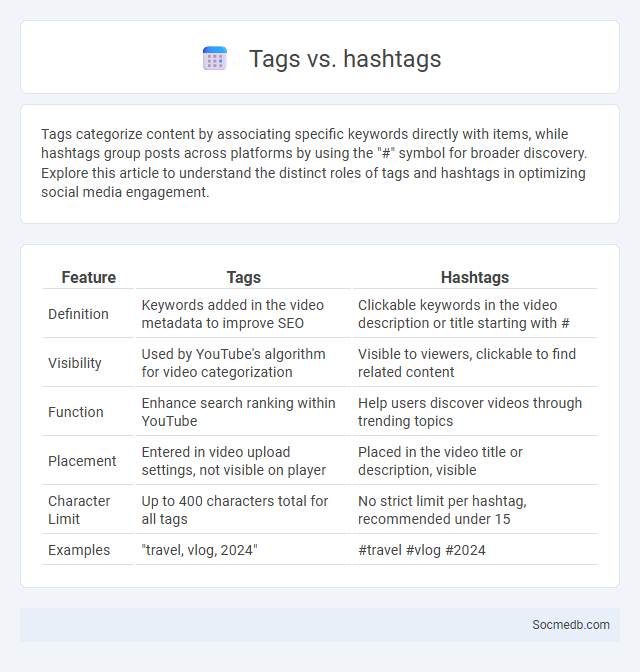
Photo illustration: tags vs hashtags
Tags categorize content by associating specific keywords directly with items, while hashtags group posts across platforms by using the "#" symbol for broader discovery. Explore this article to understand the distinct roles of tags and hashtags in optimizing social media engagement.
Table of Comparison
| Feature | Tags | Hashtags |
|---|---|---|
| Definition | Keywords added in the video metadata to improve SEO | Clickable keywords in the video description or title starting with # |
| Visibility | Used by YouTube's algorithm for video categorization | Visible to viewers, clickable to find related content |
| Function | Enhance search ranking within YouTube | Help users discover videos through trending topics |
| Placement | Entered in video upload settings, not visible on player | Placed in the video title or description, visible |
| Character Limit | Up to 400 characters total for all tags | No strict limit per hashtag, recommended under 15 |
| Examples | "travel, vlog, 2024" | #travel #vlog #2024 |
Introduction: Understanding Tags, Hashtags, and Metadata
Tags, hashtags, and metadata play crucial roles in organizing and enhancing the visibility of your social media content. Tags categorize posts by linking related topics, while hashtags boost discoverability by grouping content under trending keywords. Metadata provides detailed information about your posts, improving search relevance and user engagement on platforms like Instagram, Twitter, and Facebook.
Defining Tags, Hashtags, and Metadata
Tags, hashtags, and metadata enhance social media content discoverability and engagement by organizing information and connecting users with relevant topics. Hashtags, denoted by the "#" symbol, categorize posts under trending themes, while tags typically reference users or specific subjects to increase reach. Understanding metadata, which includes hidden data like timestamps, geolocation, and descriptions, empowers you to optimize content visibility and track performance effectively.
Key Differences Between Tags, Hashtags, and Metadata
Tags are user-generated labels that categorize content within a platform, allowing users to easily find related posts or topics. Hashtags function as clickable links that organize content across social media platforms by keyword, enabling broader searchability and trend tracking. Metadata, embedded within digital files, provides detailed information about the content such as creator, date, and format, enhancing search engine optimization and content management beyond user interaction.
Importance of Tags in Content Organization
Tags play a crucial role in content organization on social media by categorizing posts, enhancing searchability, and increasing user engagement. They enable platforms like Instagram, Twitter, and TikTok to efficiently index content, making it easier for users to discover relevant topics and trends. Proper use of hashtags and keywords improves visibility and boosts the algorithmic ranking of posts, driving greater reach and interaction.
The Role of Hashtags in Social Media Discovery
Hashtags play a crucial role in social media discovery by categorizing content and increasing visibility across platforms like Instagram, Twitter, and TikTok. Your posts become more discoverable to targeted audiences when relevant hashtags are used strategically, driving engagement and expanding reach. Optimizing hashtag selection with trending and niche tags enhances the chances of connecting with users interested in specific topics or communities.
How Metadata Enhances Search Engine Optimization
Metadata plays a critical role in enhancing Search Engine Optimization (SEO) by providing search engines with structured information about web content, such as title tags, meta descriptions, and keywords. This structured data improves indexing accuracy and increases the likelihood of higher rankings in search engine results pages (SERPs), thereby driving more organic traffic. Optimized metadata also enhances social media sharing by generating rich snippets that boost click-through rates and improve user engagement.
Best Practices for Using Tags Effectively
To maximize engagement on social media, use relevant and specific hashtags that align with your content and target audience, ensuring they enhance discoverability without cluttering posts. Research trending and niche tags within your industry to tap into active communities and increase visibility. Consistently analyze tag performance through platform analytics to refine your strategy and prioritize those driving meaningful interactions.
Optimizing Hashtags for Greater Reach
Strategically selecting and tailoring hashtags based on trending keywords and audience interests significantly boosts social media visibility and engagement rates. Incorporating a mix of popular, niche, and branded hashtags improves discoverability across platforms like Instagram, Twitter, and TikTok. Regularly analyzing hashtag performance through analytics tools refines targeting, maximizing reach and fostering community growth.
Integrating Metadata into Your Content Strategy
Integrating metadata into your social media content strategy enhances content discoverability and optimizes search engine rankings across platforms like Instagram, Facebook, and Twitter. Metadata elements such as tags, descriptions, and alt text improve audience targeting and engagement by making your posts easier to find and categorize. You can boost social media performance and drive more organic traffic by consistently applying relevant metadata to every piece of content you publish.
Conclusion: Choosing the Right Tools for Content Visibility
Selecting the right social media tools is essential for maximizing content visibility and engagement. Platforms like Instagram, TikTok, and LinkedIn offer unique algorithms and audience demographics that can be leveraged for targeted reach. Effective use of analytics and scheduling tools such as Hootsuite or Buffer enhances content performance by optimizing posting times and monitoring audience interaction.
 socmedb.com
socmedb.com